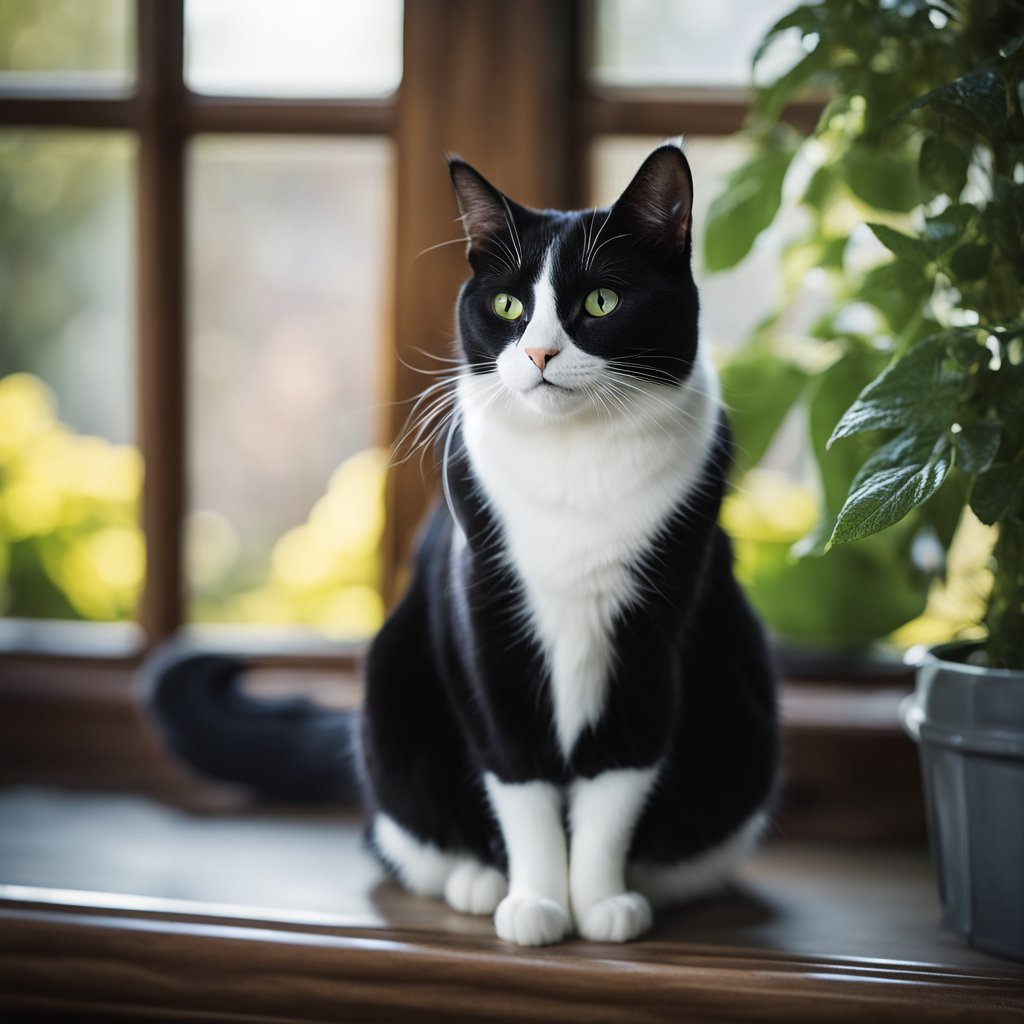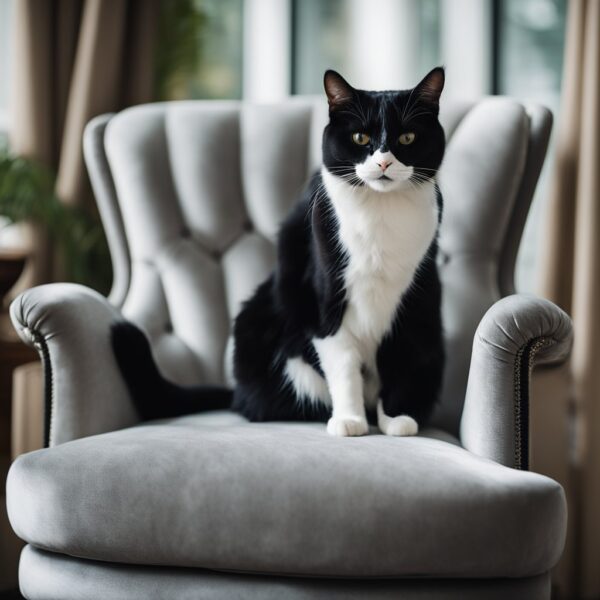
Tuxedo Cats: Their Dapper Black and White Coat
Tuxedo cats boast a distinctive bi-colored coat that resembles formal evening wear. Traditionally, these felines have a black and white pattern, with the white coloration typically appearing on their paws, chest, and face. This striking contrast has not only made them a popular choice amongst cat enthusiasts but also a subject of various cultural references throughout history. Their appearance has contributed to a number of superstitious beliefs and artistic symbolism, rendering them iconic in numerous societies.
Despite their fame, it’s critical to note that being a ‘tuxedo’ cat is not related to a specific breed but rather a color pattern that can occur in many different breeds. Consequently, the personality traits and behavior of these black and white cats can be as varied as those found within any other coloration of cats. It is essential to understand that coat color is not an indicator of a cat’s intelligence or temperament. Choosing a tuxedo cat, like any pet adoption, should be based on compatibility with the cat’s character and the owner’s lifestyle rather than color pattern alone.
Key Takeaways
- Tuxedo cats are recognized for their unique black and white coat pattern.
- They are not a particular breed, but can have varied personalities and behaviors.
- The choice to adopt a tuxedo cat should be grounded in compatibility over appearance.
History and Origin
Tuxedo cats are known for their distinctive black and white “tuxedo” coat pattern. This bicolor pattern is not specific to a breed, but rather a common coloration in domestic cats. It involves a black background with white fur on the chest, paws, and sometimes the face or abdomen.
Ancient Egypt Influence
Ancient Egyptian culture exhibited a profound reverence for cats, which they associated with deities and even mummified alongside humans. The tuxedo pattern, while not specifically documented in ancient texts, bears a striking resemblance to depictions found on murals and in sculptures of cats from this era.
| Element | Association with Ancient Egypt |
|---|---|
| Tuxedo pattern | Likened to artistic cat representations |
| Cultural significance | Cats revered and mummified |
Famous Historical Figures
Several historical figures throughout history have shown an affinity for tuxedo cats.
William Shakespeare is thought to have been fond of these cats, as allusions to them appear in his plays. For instance, some interpretations of his work suggest references to black and white-patterned cats.
Tuxedo Stan, a cat from Halifax, Nova Scotia, became a famous figure when he “ran” for mayor, drawing attention to the issue of homeless cats.
During World War I, the black and white cats were seen as mascots and companions in the trenches, providing comfort to soldiers.
In animation, tuxedo cats have been immortalized by characters such as Felix the Cat, a silent film era icon, and Sylvester, a beloved Warner Bros. character.
- Felix the Cat: One of the first animated movie stars with a tuxedo pattern.
- Sylvester the Cat: Portrayed with a tuxedo coat in Looney Tunes.

Genetics and Biology
Exploring the genetics and biology of Tuxedo cats reveals a fascinating interplay between heredity and visual traits, especially their distinctive black and white coloration.
Color Pattern Genetics
Tuxedo cats owe their striking appearance to a specific genetic expression of the piebald gene, which is also sometimes referred to as the white spotting gene. This gene causes the white spotting on the coat, disrupting the coloration to create unique patterns. The amount of white is variable and can range from a small locket to a fully white coat with just small patches of color.
The genetics behind the color patterns of Tuxedo cats are not unique to a specific breed but can appear across various breeds. Their color patterns are a type of bicolor pattern, where the base color, typically black, is present alongside significant areas of white.
| Gene | Description |
|---|---|
| Piebald/White Spotting | Affects the distribution of melanocytes, leading to white patches of fur |
| Bicolor Pattern | A coat that features two colors, often black and a significant portion of white |
Tuxedo Pattern Distinctions
The “Tuxedo” pattern itself is characterized by a solid black coat with white patches typically on the chest, paws, and sometimes the face. This distinctive black and white pattern is comparable to a tuxedo suit—hence the name. It is important to note that this pattern is not a result of a singular gene but rather a combination of the white spotting gene’s influence on an otherwise black coat.
Here’s how these genetic factors manifest in Tuxedo cats:
- Black Color: Usually the dominant base color, determined by a separate set of genes responsible for producing melanin.
- White Patches: Result from the expression of the white spotting gene that inhibits melanocyte proliferation in certain areas, leaving those patches without pigment.
This pattern does not affect the cat’s health or temperament but is purely a matter of aesthetics that often delights cat enthusiasts and contributes to the breed’s popularity.

Behavior and Temperament
Tuxedo cats exhibit a distinct range of personality traits and interactions that contribute to their reputation as intelligent and affable companions. Their behavior and temperament vary from individual to individual, influenced by both their genetics and environment.
Personality Traits
Tuxedo cats, named for their distinctive black and white coats resembling formal attire, are frequently described as intelligent and curious. Their actions often indicate a certain level of awareness and adaptability. Owners of tuxedo cats report that these felines tend to be:
- Playful: Engaging actively with toys and games.
- Affectionate: Demonstrating attachment through cuddling and purring.
- Vocal: Communicating their needs through diverse vocalizations.
Interaction with Family and Children
Though each cat is unique, tuxedo cats are generally known for their sociable nature when it comes to interactions with family members, including children. They tend to display:
- Patience: Often show tolerance during play with younger family members.
- Sociability: Enjoy the company of their human counterparts and often participate in family activities.
On the intelligence front, these cats are adept at learning through observation, which can lead to them developing complex behaviors and even learning tricks or routines.
It is essential to nurture their intelligence and sociable nature with ongoing interaction and stimulation. The black and white cats thrive in an environment where they can express their curiosity and engage in interactive play, which also deepens their bond with family members.

Tuxedo Cats in Culture
Tuxedo cats have made distinctive appearances in various cultural mediums, often carrying symbolic significance or serving as iconic characters in entertainment.
Famous Tuxedo Cats
Sylvester – This classic Looney Tunes character is perhaps one of the most recognized tuxedo cats in animation. Known for his clever yet unsuccessful attempts to catch Tweety Bird, Sylvester is characterized by his sharp wit and persistent nature.
The Cat in the Hat – Dr. Seuss’s creation, the Cat in the Hat, is another notable black and white cat who has become a symbol of mischief and fun in children’s literature. His distinctive bow tie and tall, striped hat make him an easily recognizable figure for young readers.
Felix the Cat – A pioneering figure in the animation industry, Felix the Cat is a tuxedo cat known for his curious personality and magical bag of tricks. Since his debut in the silent film era, Felix has remained a significant character in the history of cartoons.
Symbolism and Folklore
Piebald Pattern – Tuxedo cats feature a distinctive piebald pattern, characterized by their black and white coloring. This coloration has become associated with various symbolic meanings across different cultures.
- In some folklore, tuxedo cats are thought to bring good luck.
- They are often depicted as intelligent and resourceful animals in stories and myths.
Cultural Representation – In popular culture, tuxedo cats often represent duality due to their contrasting black and white coats, symbolizing the balance of opposing forces.
- Tuxedo Stan, although not a piece of folklore, was a real-life black and white cat who became famous for his symbolic “campaign” that brought attention to the welfare of stray cats, showing that the influence of these animals extends beyond myth and into the realm of social advocacy.
Choosing a Tuxedo Cat
When selecting a black and white cat, potential cat parent should consider factors like the cat’s environment, the presence of a family. Cost can also vary greatly.
Adoption Considerations
Individuals seeking to adopt a tuxedo cat can explore various avenues such as animal shelters or rescue organizations. Shelter cats often provide the advantage of being cost-effective and come with the added benefit of giving a home to a pet in need. When adopting, one should consider:
- Coat Patterns: Tuxedo cats are characterized by their distinctive black and white coat. This coat patterning should be a clear factor in identification.
- Temperament: The personality of the cat should be compatible with the family environment.
- Health: Adopted cats typically undergo health checks; however, one should inquire about any known medical issues.
- Age: Young kittens may require more training and attention, while older cats might better suit a low-energy household.
Physical Characteristics
Tuxedo cats boast a distinctive two-toned fur pattern, typically with a solid black coat complemented by striking white markings. Their plush coat can vary in length, and these bicolor cats carry an air of sophistication attributed to their elegant fur contrast.
Coat Variations
- Fur Length: Tuxedo cats can have varying fur lengths, generally classified as either short hair or long hair.
- Color Composition: The base of their fur is predominantly solid black, with white fur typically present on the chest, face, paws, and belly.
Facial and Body Markings
- Face: They often have a white patch on the face that may look like a mask, giving each cat a unique appearance.
- Chest and Paws: A tuxedo cat’s white chest resembles a crisp, formal bib, and their paws may appear as if they’re wearing dainty mittens or socks, often with various patterns such as spotted or patches.
Notable Tuxedo Cats
Tuxedo cats, with their distinctive black and white “dinner jacket” fur, have made memorable appearances in the political sphere and as mascots, capturing the hearts of many.
Tuxedo Cats in Politics
Tuxedo Stan, a charismatic cat from Halifax, made headlines for his political run. In 2012, he was the face of the Tuxedo Party, a political movement focused on improving animal welfare. Although Stan couldn’t officially be listed as a candidate, his campaign brought significant attention to the plight of stray cats.
Tuxedo Cats as Mascots
Socks, the feline companion of President Bill Clinton, resided in the White House and became an instant celebrity. This tuxedo cat often appeared alongside the President and First Family, and his endearing personality made him an effective mascot for several causes. Socks helped to humanize the image of President Clinton and garnered its own share of public attention.
Social Aspects
Tuxedo cats display distinctive social behaviors that both charm and foster connections with humans and other pets. They integrate into family structures and exhibit unique interaction patterns that enrich the lives of their owners.
Human-Cat Relationship
Tuxedo cats are known for their sociable nature, often forming strong bonds with their human families. They tend to be playful, making them excellent companions for children and adults alike. They exhibit a range of behaviors from following family members around the house to engaging in interactive play that reinforces their role within the social structure of the family.
- Children: Tuxedo cats typically demonstrate patience and playfulness, making them suitable pets for families with children.
- Socialization: They generally adapt well to new environments and people, showing ease in socialization which is crucial in busy, interactive households.
Tuxedo Cat Interaction with Other Pets
Inter-species interaction is another vital aspect of a black and white cat’s social behavior. They are often comfortable around other pets, which can include both canines and felines.
- Playfulness: Their playful nature can extend to their interactions with other pets, engaging in chase and play-fight activities that are important for their social and physical development.
- Interaction: When introduced properly, tuxedo cats can form harmonious relationships with other household pets, contributing to a balanced and socially rich environment for all.

Frequently Asked Questions
Tuxedo cats are known for their distinctive black and white coat, resembling a formal tuxedo. This section aims to address some of the most common inquiries about these charming felines.
What personality traits are commonly associated with tuxedo cats?
Tuxedo cats are often described as outgoing and intelligent. They tend to be energetic and playful which can contribute to their distinct personality.
Is it true that tuxedo cats exhibit a higher level of affection compared to other color patterns?
There is a popular belief that tuxedo cats are more affectionate than other color patterns, although there is no scientific evidence to support this notion. Like all cats, their level of affection can vary widely based on individual personality and socialization.
Can tuxedo cats be of any specific breed, or do they belong to a mixture of breeds?
Tuxedo is a color pattern, not a breed. Therefore, black and white cats can be found in various breeds and also in mixed-breed populations. The pattern is characterized by a primarily black coat with white patches on the chest, paws, and face.
What is the prevalence of tuxedo cats within the general cat population?
The tuxedo pattern is quite common among cats. While exact figures are not available, it is a widely occurring pattern that is not limited to any specific region or breed.
Do tuxedo cats exhibit unique behaviors that distinguish them from other felines?
There are no unique behaviors that are scientifically proven to be associated solely with black and white cats. Their behavior, like that of other cats, depends on a mixture of genetics and environment.
Have any tuxedo cats gained notoriety or fame, and can you name a few?
Several tuxedo cats have gained fame, often as characters in popular culture or as mascots. Historical and cultural depictions, such as Ancient Egyptian art, do not specifically feature the black and white pattern, but many contemporary famous cats, like Socks, the cat owned by former US President Bill Clinton, have been tuxedo cats.